Nursing Assignment: E-Portfolio Assessment, Collaborative and Therapeutic Practice, Module 3 and 4
VerifiedAdded on 2023/06/03
|13
|2964
|348
AI Summary
This nursing assignment covers E-Portfolio Assessment, Collaborative and Therapeutic Practice, Module 3 and 4. It includes priorities of nursing care, multidisciplinary team, ethical dilemma, physical examination, and delegation of nursing tasks.
Contribute Materials
Your contribution can guide someone’s learning journey. Share your
documents today.

Running head: NURSING ASSIGNMENT
NURSING ASSIGNMENT
Name of the Student
Name of the university
Author’s note
NURSING ASSIGNMENT
Name of the Student
Name of the university
Author’s note
Secure Best Marks with AI Grader
Need help grading? Try our AI Grader for instant feedback on your assignments.
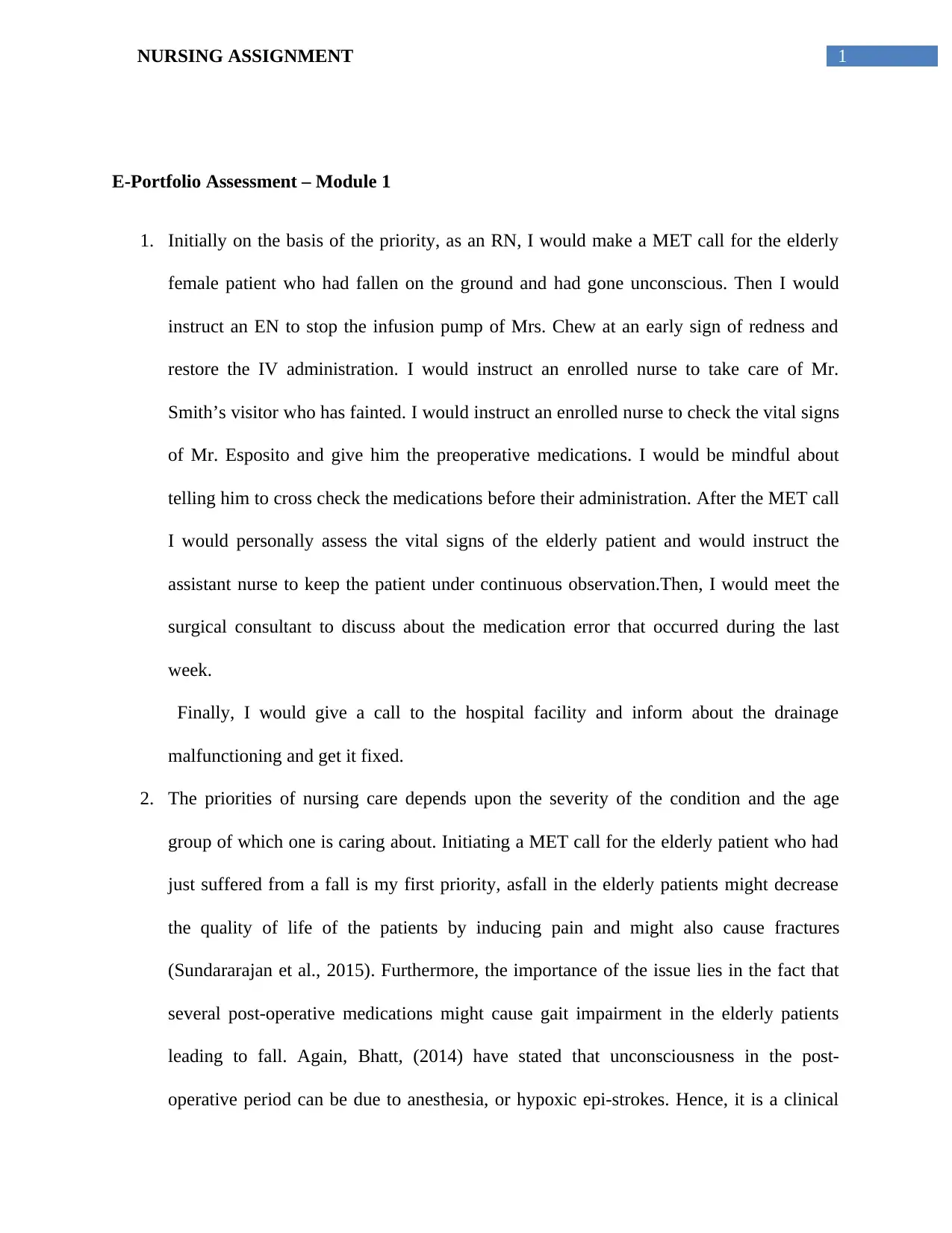
1NURSING ASSIGNMENT
E-Portfolio Assessment – Module 1
1. Initially on the basis of the priority, as an RN, I would make a MET call for the elderly
female patient who had fallen on the ground and had gone unconscious. Then I would
instruct an EN to stop the infusion pump of Mrs. Chew at an early sign of redness and
restore the IV administration. I would instruct an enrolled nurse to take care of Mr.
Smith’s visitor who has fainted. I would instruct an enrolled nurse to check the vital signs
of Mr. Esposito and give him the preoperative medications. I would be mindful about
telling him to cross check the medications before their administration. After the MET call
I would personally assess the vital signs of the elderly patient and would instruct the
assistant nurse to keep the patient under continuous observation.Then, I would meet the
surgical consultant to discuss about the medication error that occurred during the last
week.
Finally, I would give a call to the hospital facility and inform about the drainage
malfunctioning and get it fixed.
2. The priorities of nursing care depends upon the severity of the condition and the age
group of which one is caring about. Initiating a MET call for the elderly patient who had
just suffered from a fall is my first priority, asfall in the elderly patients might decrease
the quality of life of the patients by inducing pain and might also cause fractures
(Sundararajan et al., 2015). Furthermore, the importance of the issue lies in the fact that
several post-operative medications might cause gait impairment in the elderly patients
leading to fall. Again, Bhatt, (2014) have stated that unconsciousness in the post-
operative period can be due to anesthesia, or hypoxic epi-strokes. Hence, it is a clinical
E-Portfolio Assessment – Module 1
1. Initially on the basis of the priority, as an RN, I would make a MET call for the elderly
female patient who had fallen on the ground and had gone unconscious. Then I would
instruct an EN to stop the infusion pump of Mrs. Chew at an early sign of redness and
restore the IV administration. I would instruct an enrolled nurse to take care of Mr.
Smith’s visitor who has fainted. I would instruct an enrolled nurse to check the vital signs
of Mr. Esposito and give him the preoperative medications. I would be mindful about
telling him to cross check the medications before their administration. After the MET call
I would personally assess the vital signs of the elderly patient and would instruct the
assistant nurse to keep the patient under continuous observation.Then, I would meet the
surgical consultant to discuss about the medication error that occurred during the last
week.
Finally, I would give a call to the hospital facility and inform about the drainage
malfunctioning and get it fixed.
2. The priorities of nursing care depends upon the severity of the condition and the age
group of which one is caring about. Initiating a MET call for the elderly patient who had
just suffered from a fall is my first priority, asfall in the elderly patients might decrease
the quality of life of the patients by inducing pain and might also cause fractures
(Sundararajan et al., 2015). Furthermore, the importance of the issue lies in the fact that
several post-operative medications might cause gait impairment in the elderly patients
leading to fall. Again, Bhatt, (2014) have stated that unconsciousness in the post-
operative period can be due to anesthesia, or hypoxic epi-strokes. Hence, it is a clinical
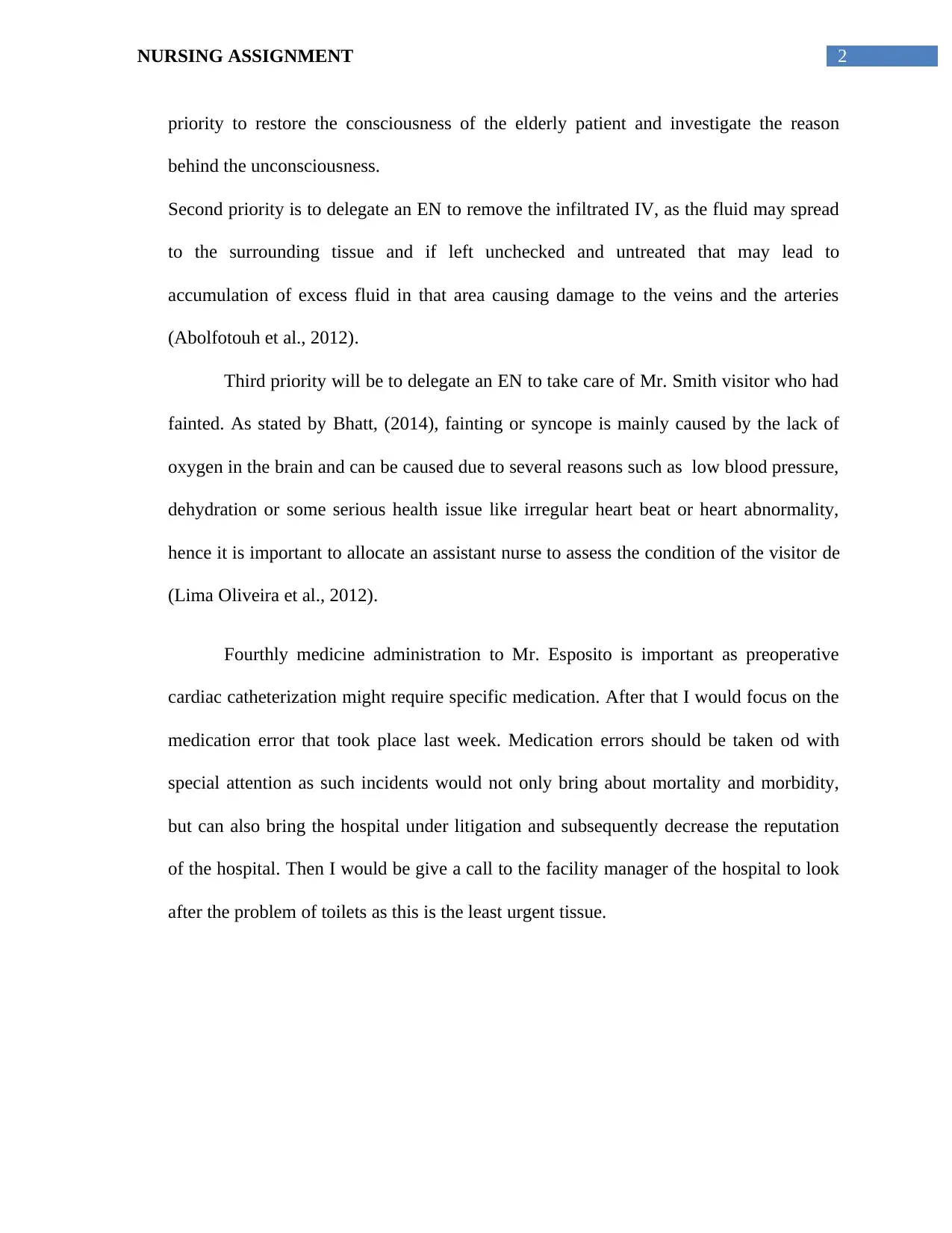
2NURSING ASSIGNMENT
priority to restore the consciousness of the elderly patient and investigate the reason
behind the unconsciousness.
Second priority is to delegate an EN to remove the infiltrated IV, as the fluid may spread
to the surrounding tissue and if left unchecked and untreated that may lead to
accumulation of excess fluid in that area causing damage to the veins and the arteries
(Abolfotouh et al., 2012).
Third priority will be to delegate an EN to take care of Mr. Smith visitor who had
fainted. As stated by Bhatt, (2014), fainting or syncope is mainly caused by the lack of
oxygen in the brain and can be caused due to several reasons such as low blood pressure,
dehydration or some serious health issue like irregular heart beat or heart abnormality,
hence it is important to allocate an assistant nurse to assess the condition of the visitor de
(Lima Oliveira et al., 2012).
Fourthly medicine administration to Mr. Esposito is important as preoperative
cardiac catheterization might require specific medication. After that I would focus on the
medication error that took place last week. Medication errors should be taken od with
special attention as such incidents would not only bring about mortality and morbidity,
but can also bring the hospital under litigation and subsequently decrease the reputation
of the hospital. Then I would be give a call to the facility manager of the hospital to look
after the problem of toilets as this is the least urgent tissue.
priority to restore the consciousness of the elderly patient and investigate the reason
behind the unconsciousness.
Second priority is to delegate an EN to remove the infiltrated IV, as the fluid may spread
to the surrounding tissue and if left unchecked and untreated that may lead to
accumulation of excess fluid in that area causing damage to the veins and the arteries
(Abolfotouh et al., 2012).
Third priority will be to delegate an EN to take care of Mr. Smith visitor who had
fainted. As stated by Bhatt, (2014), fainting or syncope is mainly caused by the lack of
oxygen in the brain and can be caused due to several reasons such as low blood pressure,
dehydration or some serious health issue like irregular heart beat or heart abnormality,
hence it is important to allocate an assistant nurse to assess the condition of the visitor de
(Lima Oliveira et al., 2012).
Fourthly medicine administration to Mr. Esposito is important as preoperative
cardiac catheterization might require specific medication. After that I would focus on the
medication error that took place last week. Medication errors should be taken od with
special attention as such incidents would not only bring about mortality and morbidity,
but can also bring the hospital under litigation and subsequently decrease the reputation
of the hospital. Then I would be give a call to the facility manager of the hospital to look
after the problem of toilets as this is the least urgent tissue.
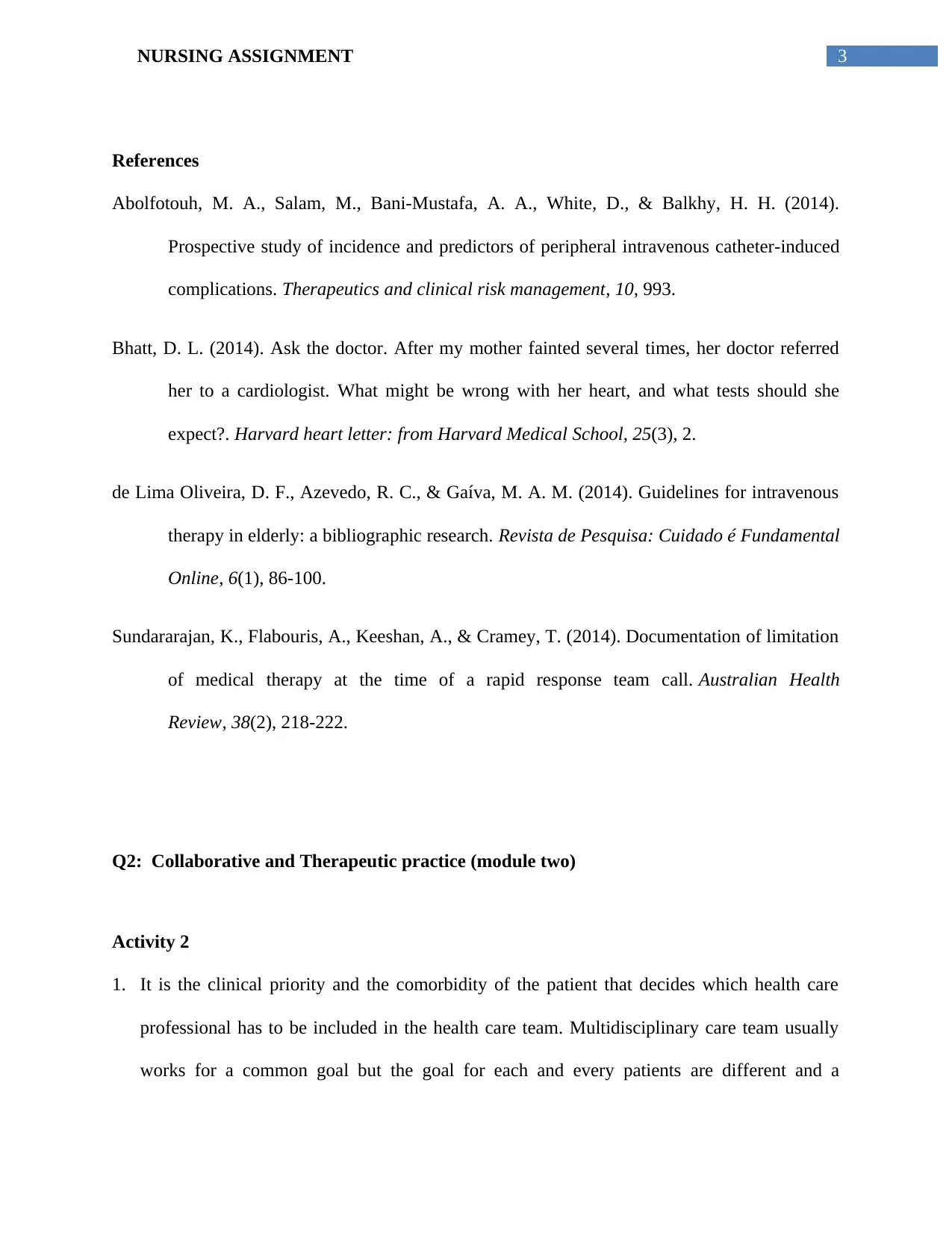
3NURSING ASSIGNMENT
References
Abolfotouh, M. A., Salam, M., Bani-Mustafa, A. A., White, D., & Balkhy, H. H. (2014).
Prospective study of incidence and predictors of peripheral intravenous catheter-induced
complications. Therapeutics and clinical risk management, 10, 993.
Bhatt, D. L. (2014). Ask the doctor. After my mother fainted several times, her doctor referred
her to a cardiologist. What might be wrong with her heart, and what tests should she
expect?. Harvard heart letter: from Harvard Medical School, 25(3), 2.
de Lima Oliveira, D. F., Azevedo, R. C., & Gaíva, M. A. M. (2014). Guidelines for intravenous
therapy in elderly: a bibliographic research. Revista de Pesquisa: Cuidado é Fundamental
Online, 6(1), 86-100.
Sundararajan, K., Flabouris, A., Keeshan, A., & Cramey, T. (2014). Documentation of limitation
of medical therapy at the time of a rapid response team call. Australian Health
Review, 38(2), 218-222.
Q2: Collaborative and Therapeutic practice (module two)
Activity 2
1. It is the clinical priority and the comorbidity of the patient that decides which health care
professional has to be included in the health care team. Multidisciplinary care team usually
works for a common goal but the goal for each and every patients are different and a
References
Abolfotouh, M. A., Salam, M., Bani-Mustafa, A. A., White, D., & Balkhy, H. H. (2014).
Prospective study of incidence and predictors of peripheral intravenous catheter-induced
complications. Therapeutics and clinical risk management, 10, 993.
Bhatt, D. L. (2014). Ask the doctor. After my mother fainted several times, her doctor referred
her to a cardiologist. What might be wrong with her heart, and what tests should she
expect?. Harvard heart letter: from Harvard Medical School, 25(3), 2.
de Lima Oliveira, D. F., Azevedo, R. C., & Gaíva, M. A. M. (2014). Guidelines for intravenous
therapy in elderly: a bibliographic research. Revista de Pesquisa: Cuidado é Fundamental
Online, 6(1), 86-100.
Sundararajan, K., Flabouris, A., Keeshan, A., & Cramey, T. (2014). Documentation of limitation
of medical therapy at the time of a rapid response team call. Australian Health
Review, 38(2), 218-222.
Q2: Collaborative and Therapeutic practice (module two)
Activity 2
1. It is the clinical priority and the comorbidity of the patient that decides which health care
professional has to be included in the health care team. Multidisciplinary care team usually
works for a common goal but the goal for each and every patients are different and a
Paraphrase This Document
Need a fresh take? Get an instant paraphrase of this document with our AI Paraphraser
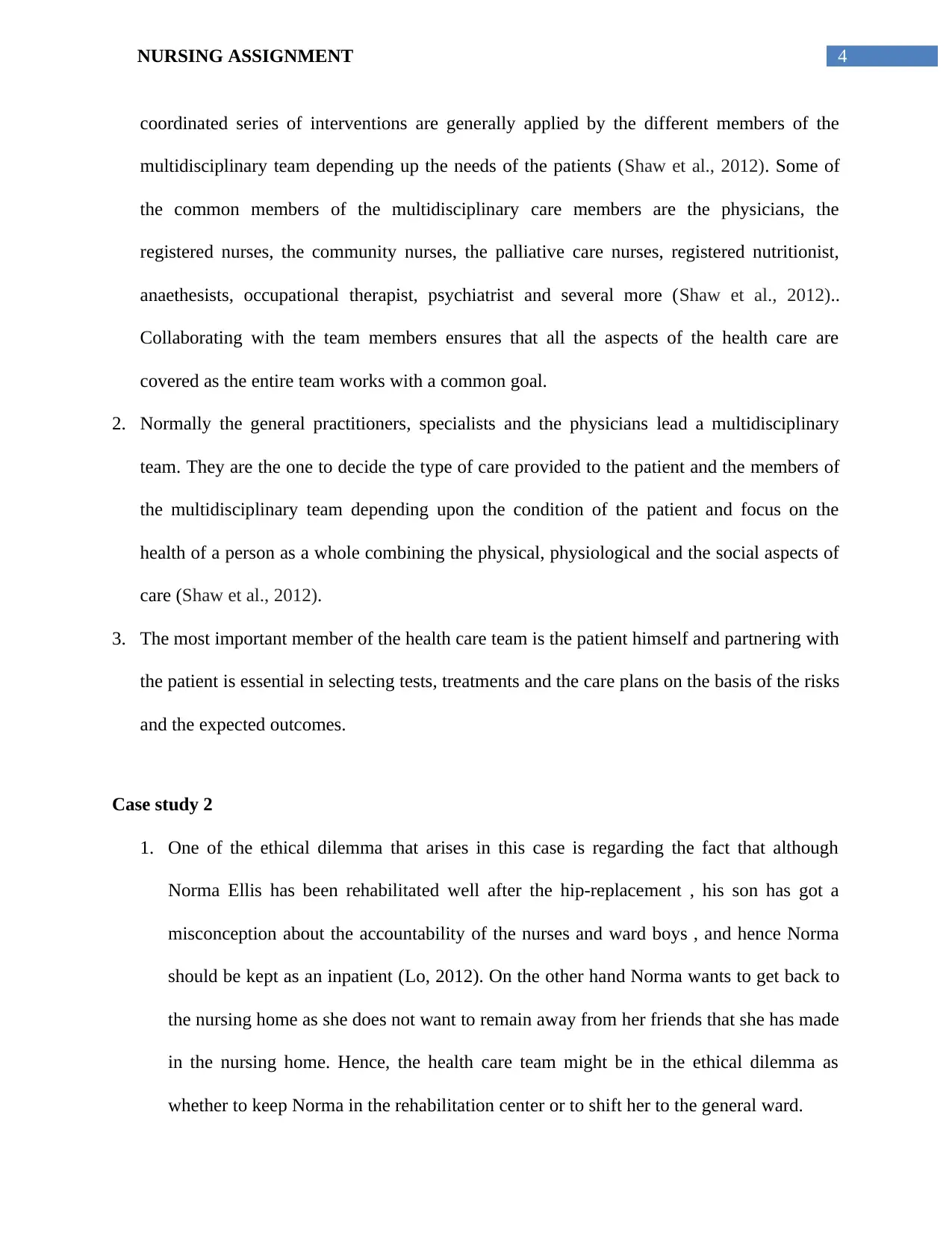
4NURSING ASSIGNMENT
coordinated series of interventions are generally applied by the different members of the
multidisciplinary team depending up the needs of the patients (Shaw et al., 2012). Some of
the common members of the multidisciplinary care members are the physicians, the
registered nurses, the community nurses, the palliative care nurses, registered nutritionist,
anaethesists, occupational therapist, psychiatrist and several more (Shaw et al., 2012)..
Collaborating with the team members ensures that all the aspects of the health care are
covered as the entire team works with a common goal.
2. Normally the general practitioners, specialists and the physicians lead a multidisciplinary
team. They are the one to decide the type of care provided to the patient and the members of
the multidisciplinary team depending upon the condition of the patient and focus on the
health of a person as a whole combining the physical, physiological and the social aspects of
care (Shaw et al., 2012).
3. The most important member of the health care team is the patient himself and partnering with
the patient is essential in selecting tests, treatments and the care plans on the basis of the risks
and the expected outcomes.
Case study 2
1. One of the ethical dilemma that arises in this case is regarding the fact that although
Norma Ellis has been rehabilitated well after the hip-replacement , his son has got a
misconception about the accountability of the nurses and ward boys , and hence Norma
should be kept as an inpatient (Lo, 2012). On the other hand Norma wants to get back to
the nursing home as she does not want to remain away from her friends that she has made
in the nursing home. Hence, the health care team might be in the ethical dilemma as
whether to keep Norma in the rehabilitation center or to shift her to the general ward.
coordinated series of interventions are generally applied by the different members of the
multidisciplinary team depending up the needs of the patients (Shaw et al., 2012). Some of
the common members of the multidisciplinary care members are the physicians, the
registered nurses, the community nurses, the palliative care nurses, registered nutritionist,
anaethesists, occupational therapist, psychiatrist and several more (Shaw et al., 2012)..
Collaborating with the team members ensures that all the aspects of the health care are
covered as the entire team works with a common goal.
2. Normally the general practitioners, specialists and the physicians lead a multidisciplinary
team. They are the one to decide the type of care provided to the patient and the members of
the multidisciplinary team depending upon the condition of the patient and focus on the
health of a person as a whole combining the physical, physiological and the social aspects of
care (Shaw et al., 2012).
3. The most important member of the health care team is the patient himself and partnering with
the patient is essential in selecting tests, treatments and the care plans on the basis of the risks
and the expected outcomes.
Case study 2
1. One of the ethical dilemma that arises in this case is regarding the fact that although
Norma Ellis has been rehabilitated well after the hip-replacement , his son has got a
misconception about the accountability of the nurses and ward boys , and hence Norma
should be kept as an inpatient (Lo, 2012). On the other hand Norma wants to get back to
the nursing home as she does not want to remain away from her friends that she has made
in the nursing home. Hence, the health care team might be in the ethical dilemma as
whether to keep Norma in the rehabilitation center or to shift her to the general ward.
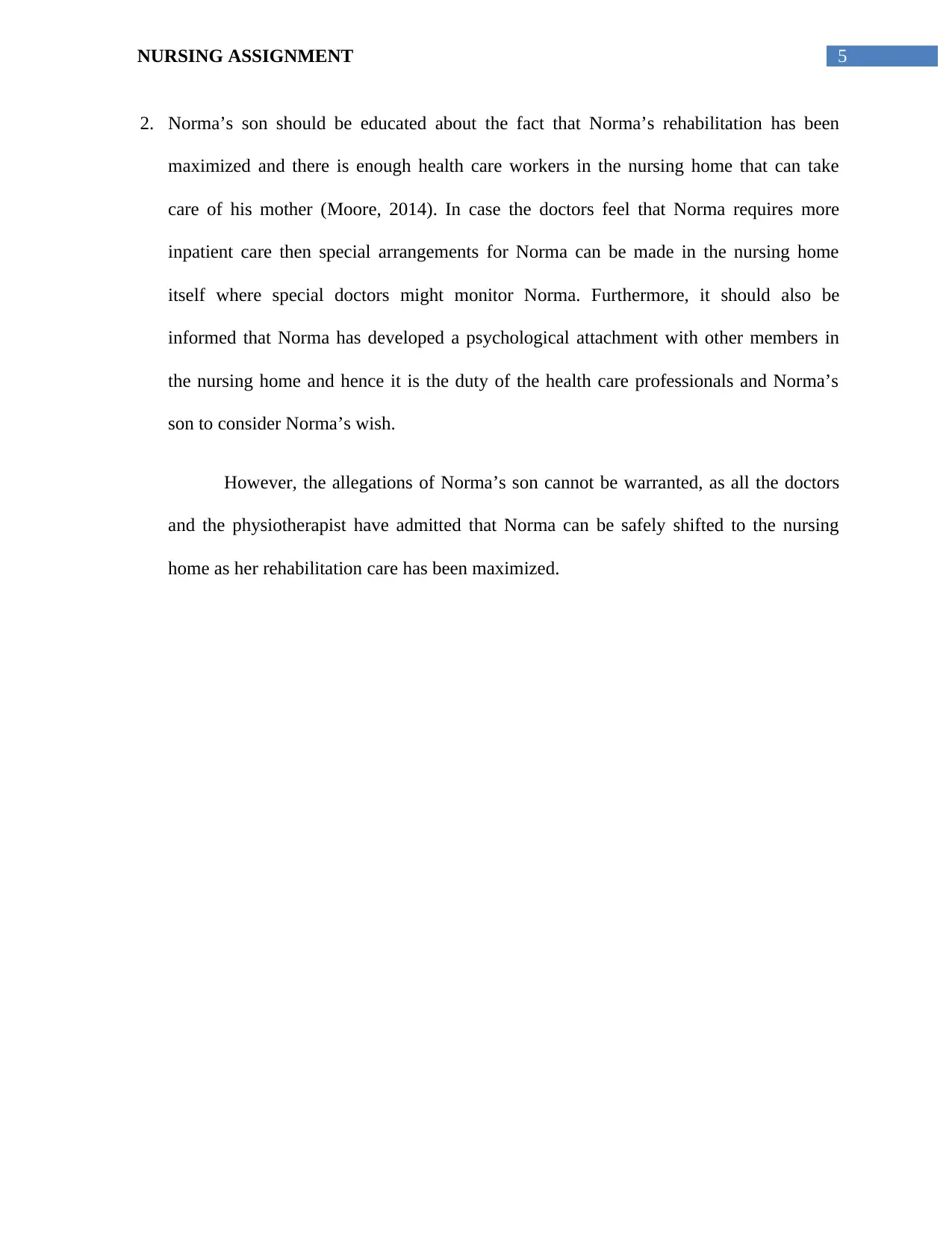
5NURSING ASSIGNMENT
2. Norma’s son should be educated about the fact that Norma’s rehabilitation has been
maximized and there is enough health care workers in the nursing home that can take
care of his mother (Moore, 2014). In case the doctors feel that Norma requires more
inpatient care then special arrangements for Norma can be made in the nursing home
itself where special doctors might monitor Norma. Furthermore, it should also be
informed that Norma has developed a psychological attachment with other members in
the nursing home and hence it is the duty of the health care professionals and Norma’s
son to consider Norma’s wish.
However, the allegations of Norma’s son cannot be warranted, as all the doctors
and the physiotherapist have admitted that Norma can be safely shifted to the nursing
home as her rehabilitation care has been maximized.
2. Norma’s son should be educated about the fact that Norma’s rehabilitation has been
maximized and there is enough health care workers in the nursing home that can take
care of his mother (Moore, 2014). In case the doctors feel that Norma requires more
inpatient care then special arrangements for Norma can be made in the nursing home
itself where special doctors might monitor Norma. Furthermore, it should also be
informed that Norma has developed a psychological attachment with other members in
the nursing home and hence it is the duty of the health care professionals and Norma’s
son to consider Norma’s wish.
However, the allegations of Norma’s son cannot be warranted, as all the doctors
and the physiotherapist have admitted that Norma can be safely shifted to the nursing
home as her rehabilitation care has been maximized.
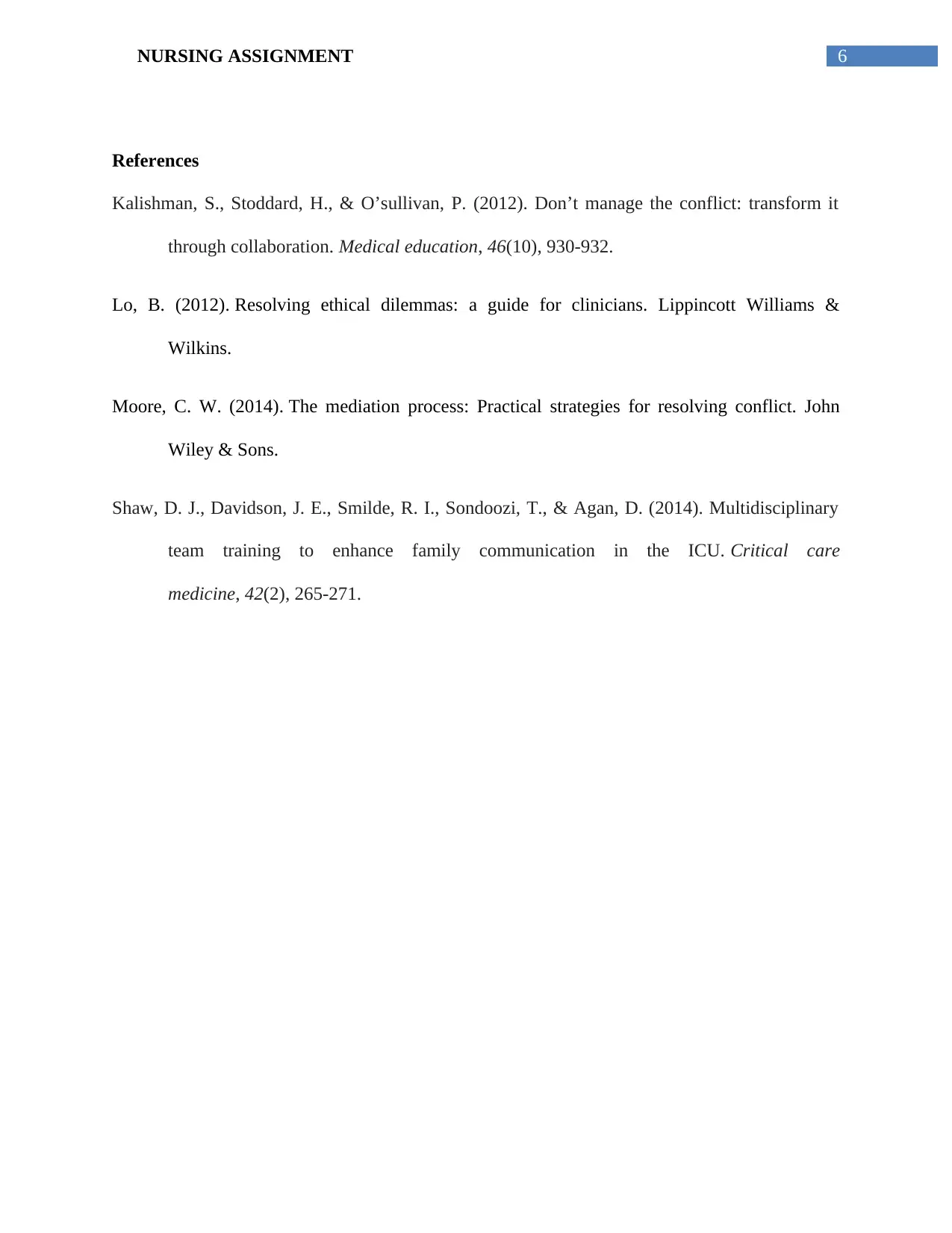
6NURSING ASSIGNMENT
References
Kalishman, S., Stoddard, H., & O’sullivan, P. (2012). Don’t manage the conflict: transform it
through collaboration. Medical education, 46(10), 930-932.
Lo, B. (2012). Resolving ethical dilemmas: a guide for clinicians. Lippincott Williams &
Wilkins.
Moore, C. W. (2014). The mediation process: Practical strategies for resolving conflict. John
Wiley & Sons.
Shaw, D. J., Davidson, J. E., Smilde, R. I., Sondoozi, T., & Agan, D. (2014). Multidisciplinary
team training to enhance family communication in the ICU. Critical care
medicine, 42(2), 265-271.
References
Kalishman, S., Stoddard, H., & O’sullivan, P. (2012). Don’t manage the conflict: transform it
through collaboration. Medical education, 46(10), 930-932.
Lo, B. (2012). Resolving ethical dilemmas: a guide for clinicians. Lippincott Williams &
Wilkins.
Moore, C. W. (2014). The mediation process: Practical strategies for resolving conflict. John
Wiley & Sons.
Shaw, D. J., Davidson, J. E., Smilde, R. I., Sondoozi, T., & Agan, D. (2014). Multidisciplinary
team training to enhance family communication in the ICU. Critical care
medicine, 42(2), 265-271.
Secure Best Marks with AI Grader
Need help grading? Try our AI Grader for instant feedback on your assignments.

7NURSING ASSIGNMENT
Module 3
1. The following questions should be asked to the emergency department nurse:-
Name of the patient
The date and the time of admission of the patient?
Does the patient have any family?
Who is the primary contact of the patient if something was to happen?
Does the patient require assistance in eating, showering or using the washroom?
Does the patient have pain? How should we control the pain? What medications? When
is the medicine due next? (Klim et al., 2016)
Is the patient conscious and oriented to space and time?
Is the patient allergic to any food or drugs?
Is the patient a telemetry or a non-monitored patient?
If the patient has had a congestive heart failure, then I would enquire whether the patient
was on fluid resuscitation (Bickley & Szilagyi, 2012).
I would ask for any abnormal observations in the vital signs?
If the patient is wounded then, when is the wound care dressing change due?
2.When the patient further arrives at the ward I would make sure to conduct the following
assessments-
First I would conduct a physical examination (Estes et al. 2016)
Checking of the vital signs at an interval of 3-4 hours (temperature, blood pressure,
heart rate, respiratory rate and the oxygen saturation level).
Module 3
1. The following questions should be asked to the emergency department nurse:-
Name of the patient
The date and the time of admission of the patient?
Does the patient have any family?
Who is the primary contact of the patient if something was to happen?
Does the patient require assistance in eating, showering or using the washroom?
Does the patient have pain? How should we control the pain? What medications? When
is the medicine due next? (Klim et al., 2016)
Is the patient conscious and oriented to space and time?
Is the patient allergic to any food or drugs?
Is the patient a telemetry or a non-monitored patient?
If the patient has had a congestive heart failure, then I would enquire whether the patient
was on fluid resuscitation (Bickley & Szilagyi, 2012).
I would ask for any abnormal observations in the vital signs?
If the patient is wounded then, when is the wound care dressing change due?
2.When the patient further arrives at the ward I would make sure to conduct the following
assessments-
First I would conduct a physical examination (Estes et al. 2016)
Checking of the vital signs at an interval of 3-4 hours (temperature, blood pressure,
heart rate, respiratory rate and the oxygen saturation level).
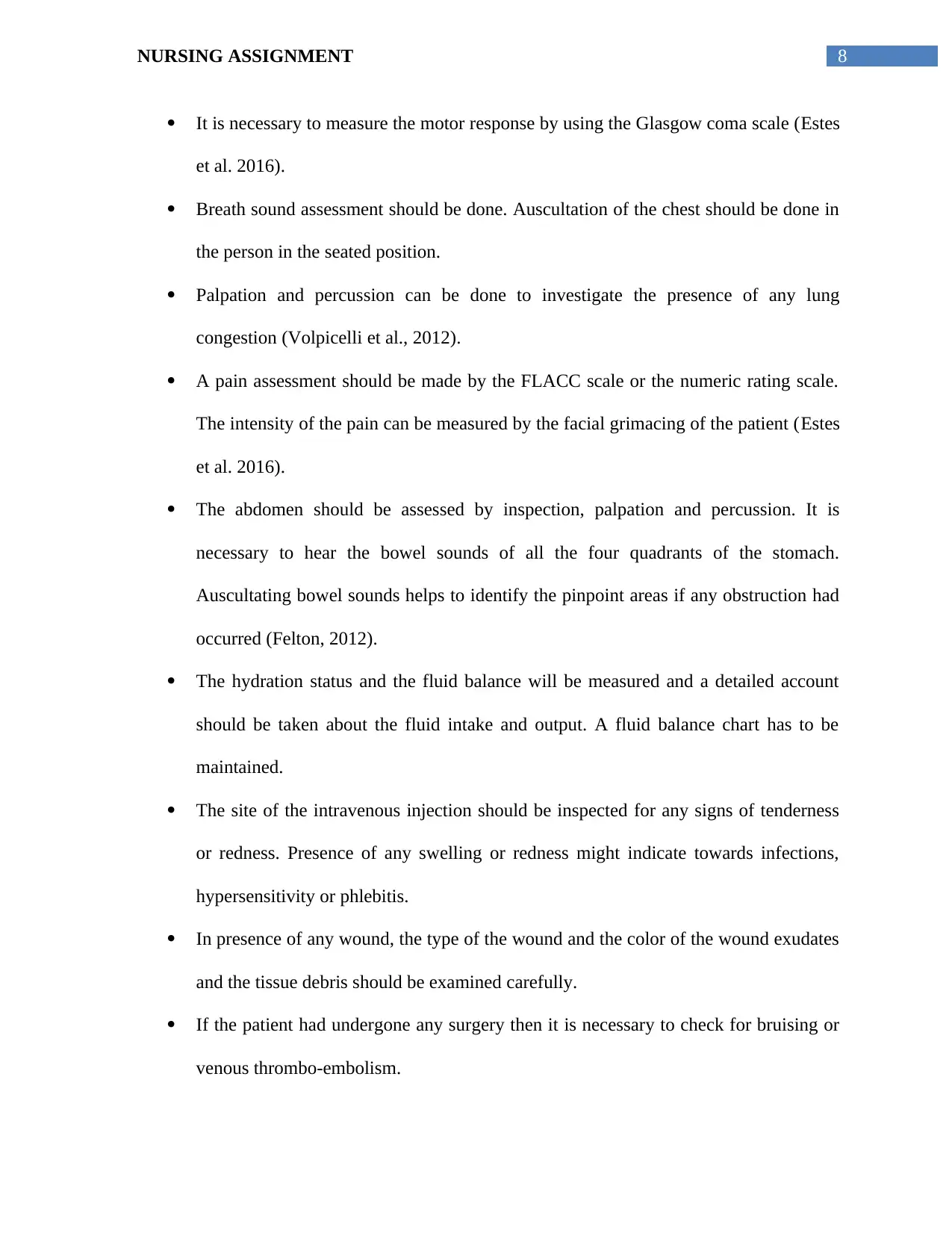
8NURSING ASSIGNMENT
It is necessary to measure the motor response by using the Glasgow coma scale (Estes
et al. 2016).
Breath sound assessment should be done. Auscultation of the chest should be done in
the person in the seated position.
Palpation and percussion can be done to investigate the presence of any lung
congestion (Volpicelli et al., 2012).
A pain assessment should be made by the FLACC scale or the numeric rating scale.
The intensity of the pain can be measured by the facial grimacing of the patient (Estes
et al. 2016).
The abdomen should be assessed by inspection, palpation and percussion. It is
necessary to hear the bowel sounds of all the four quadrants of the stomach.
Auscultating bowel sounds helps to identify the pinpoint areas if any obstruction had
occurred (Felton, 2012).
The hydration status and the fluid balance will be measured and a detailed account
should be taken about the fluid intake and output. A fluid balance chart has to be
maintained.
The site of the intravenous injection should be inspected for any signs of tenderness
or redness. Presence of any swelling or redness might indicate towards infections,
hypersensitivity or phlebitis.
In presence of any wound, the type of the wound and the color of the wound exudates
and the tissue debris should be examined carefully.
If the patient had undergone any surgery then it is necessary to check for bruising or
venous thrombo-embolism.
It is necessary to measure the motor response by using the Glasgow coma scale (Estes
et al. 2016).
Breath sound assessment should be done. Auscultation of the chest should be done in
the person in the seated position.
Palpation and percussion can be done to investigate the presence of any lung
congestion (Volpicelli et al., 2012).
A pain assessment should be made by the FLACC scale or the numeric rating scale.
The intensity of the pain can be measured by the facial grimacing of the patient (Estes
et al. 2016).
The abdomen should be assessed by inspection, palpation and percussion. It is
necessary to hear the bowel sounds of all the four quadrants of the stomach.
Auscultating bowel sounds helps to identify the pinpoint areas if any obstruction had
occurred (Felton, 2012).
The hydration status and the fluid balance will be measured and a detailed account
should be taken about the fluid intake and output. A fluid balance chart has to be
maintained.
The site of the intravenous injection should be inspected for any signs of tenderness
or redness. Presence of any swelling or redness might indicate towards infections,
hypersensitivity or phlebitis.
In presence of any wound, the type of the wound and the color of the wound exudates
and the tissue debris should be examined carefully.
If the patient had undergone any surgery then it is necessary to check for bruising or
venous thrombo-embolism.
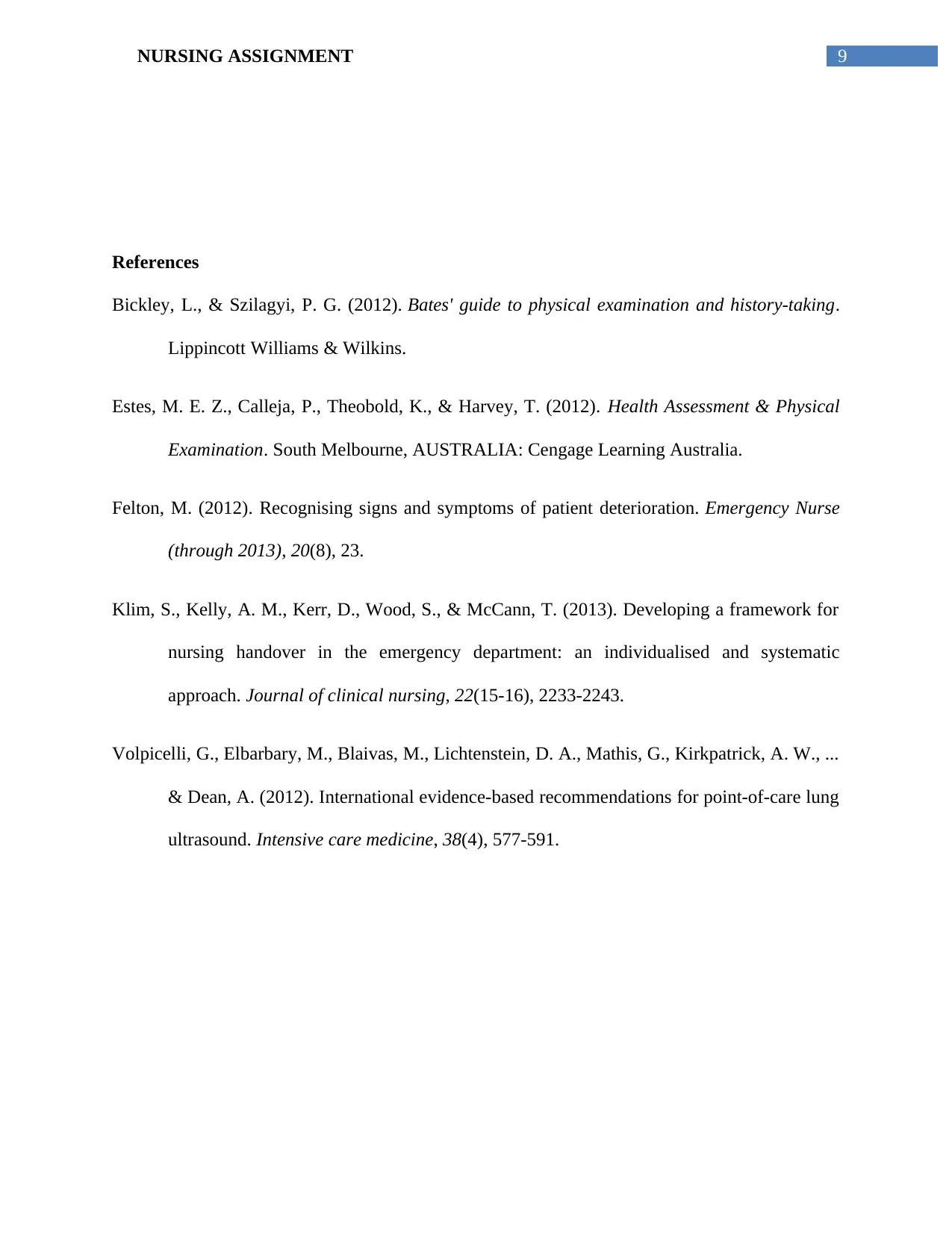
9NURSING ASSIGNMENT
References
Bickley, L., & Szilagyi, P. G. (2012). Bates' guide to physical examination and history-taking.
Lippincott Williams & Wilkins.
Estes, M. E. Z., Calleja, P., Theobold, K., & Harvey, T. (2012). Health Assessment & Physical
Examination. South Melbourne, AUSTRALIA: Cengage Learning Australia.
Felton, M. (2012). Recognising signs and symptoms of patient deterioration. Emergency Nurse
(through 2013), 20(8), 23.
Klim, S., Kelly, A. M., Kerr, D., Wood, S., & McCann, T. (2013). Developing a framework for
nursing handover in the emergency department: an individualised and systematic
approach. Journal of clinical nursing, 22(15-16), 2233-2243.
Volpicelli, G., Elbarbary, M., Blaivas, M., Lichtenstein, D. A., Mathis, G., Kirkpatrick, A. W., ...
& Dean, A. (2012). International evidence-based recommendations for point-of-care lung
ultrasound. Intensive care medicine, 38(4), 577-591.
References
Bickley, L., & Szilagyi, P. G. (2012). Bates' guide to physical examination and history-taking.
Lippincott Williams & Wilkins.
Estes, M. E. Z., Calleja, P., Theobold, K., & Harvey, T. (2012). Health Assessment & Physical
Examination. South Melbourne, AUSTRALIA: Cengage Learning Australia.
Felton, M. (2012). Recognising signs and symptoms of patient deterioration. Emergency Nurse
(through 2013), 20(8), 23.
Klim, S., Kelly, A. M., Kerr, D., Wood, S., & McCann, T. (2013). Developing a framework for
nursing handover in the emergency department: an individualised and systematic
approach. Journal of clinical nursing, 22(15-16), 2233-2243.
Volpicelli, G., Elbarbary, M., Blaivas, M., Lichtenstein, D. A., Mathis, G., Kirkpatrick, A. W., ...
& Dean, A. (2012). International evidence-based recommendations for point-of-care lung
ultrasound. Intensive care medicine, 38(4), 577-591.
Paraphrase This Document
Need a fresh take? Get an instant paraphrase of this document with our AI Paraphraser
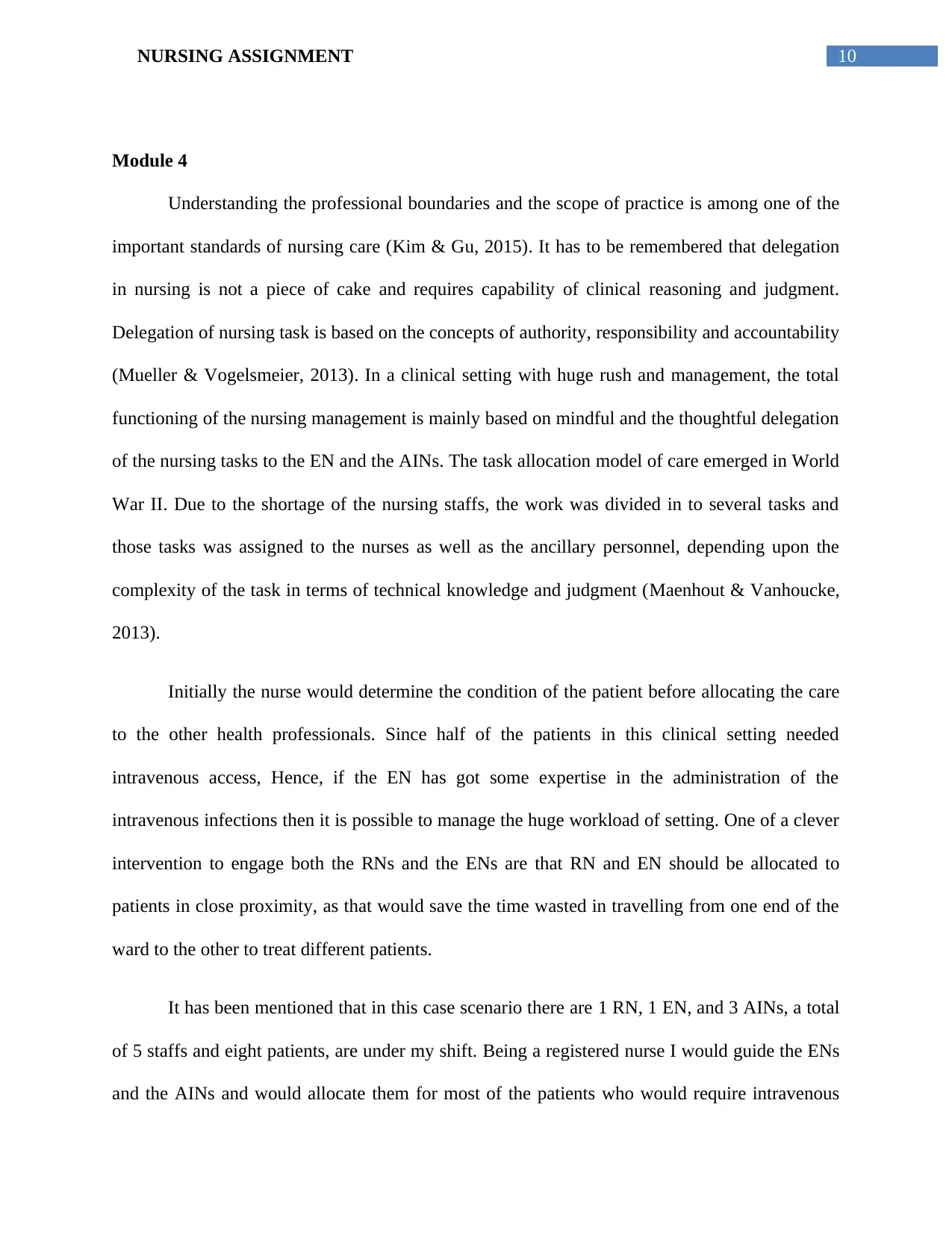
10NURSING ASSIGNMENT
Module 4
Understanding the professional boundaries and the scope of practice is among one of the
important standards of nursing care (Kim & Gu, 2015). It has to be remembered that delegation
in nursing is not a piece of cake and requires capability of clinical reasoning and judgment.
Delegation of nursing task is based on the concepts of authority, responsibility and accountability
(Mueller & Vogelsmeier, 2013). In a clinical setting with huge rush and management, the total
functioning of the nursing management is mainly based on mindful and the thoughtful delegation
of the nursing tasks to the EN and the AINs. The task allocation model of care emerged in World
War II. Due to the shortage of the nursing staffs, the work was divided in to several tasks and
those tasks was assigned to the nurses as well as the ancillary personnel, depending upon the
complexity of the task in terms of technical knowledge and judgment (Maenhout & Vanhoucke,
2013).
Initially the nurse would determine the condition of the patient before allocating the care
to the other health professionals. Since half of the patients in this clinical setting needed
intravenous access, Hence, if the EN has got some expertise in the administration of the
intravenous infections then it is possible to manage the huge workload of setting. One of a clever
intervention to engage both the RNs and the ENs are that RN and EN should be allocated to
patients in close proximity, as that would save the time wasted in travelling from one end of the
ward to the other to treat different patients.
It has been mentioned that in this case scenario there are 1 RN, 1 EN, and 3 AINs, a total
of 5 staffs and eight patients, are under my shift. Being a registered nurse I would guide the ENs
and the AINs and would allocate them for most of the patients who would require intravenous
Module 4
Understanding the professional boundaries and the scope of practice is among one of the
important standards of nursing care (Kim & Gu, 2015). It has to be remembered that delegation
in nursing is not a piece of cake and requires capability of clinical reasoning and judgment.
Delegation of nursing task is based on the concepts of authority, responsibility and accountability
(Mueller & Vogelsmeier, 2013). In a clinical setting with huge rush and management, the total
functioning of the nursing management is mainly based on mindful and the thoughtful delegation
of the nursing tasks to the EN and the AINs. The task allocation model of care emerged in World
War II. Due to the shortage of the nursing staffs, the work was divided in to several tasks and
those tasks was assigned to the nurses as well as the ancillary personnel, depending upon the
complexity of the task in terms of technical knowledge and judgment (Maenhout & Vanhoucke,
2013).
Initially the nurse would determine the condition of the patient before allocating the care
to the other health professionals. Since half of the patients in this clinical setting needed
intravenous access, Hence, if the EN has got some expertise in the administration of the
intravenous infections then it is possible to manage the huge workload of setting. One of a clever
intervention to engage both the RNs and the ENs are that RN and EN should be allocated to
patients in close proximity, as that would save the time wasted in travelling from one end of the
ward to the other to treat different patients.
It has been mentioned that in this case scenario there are 1 RN, 1 EN, and 3 AINs, a total
of 5 staffs and eight patients, are under my shift. Being a registered nurse I would guide the ENs
and the AINs and would allocate them for most of the patients who would require intravenous
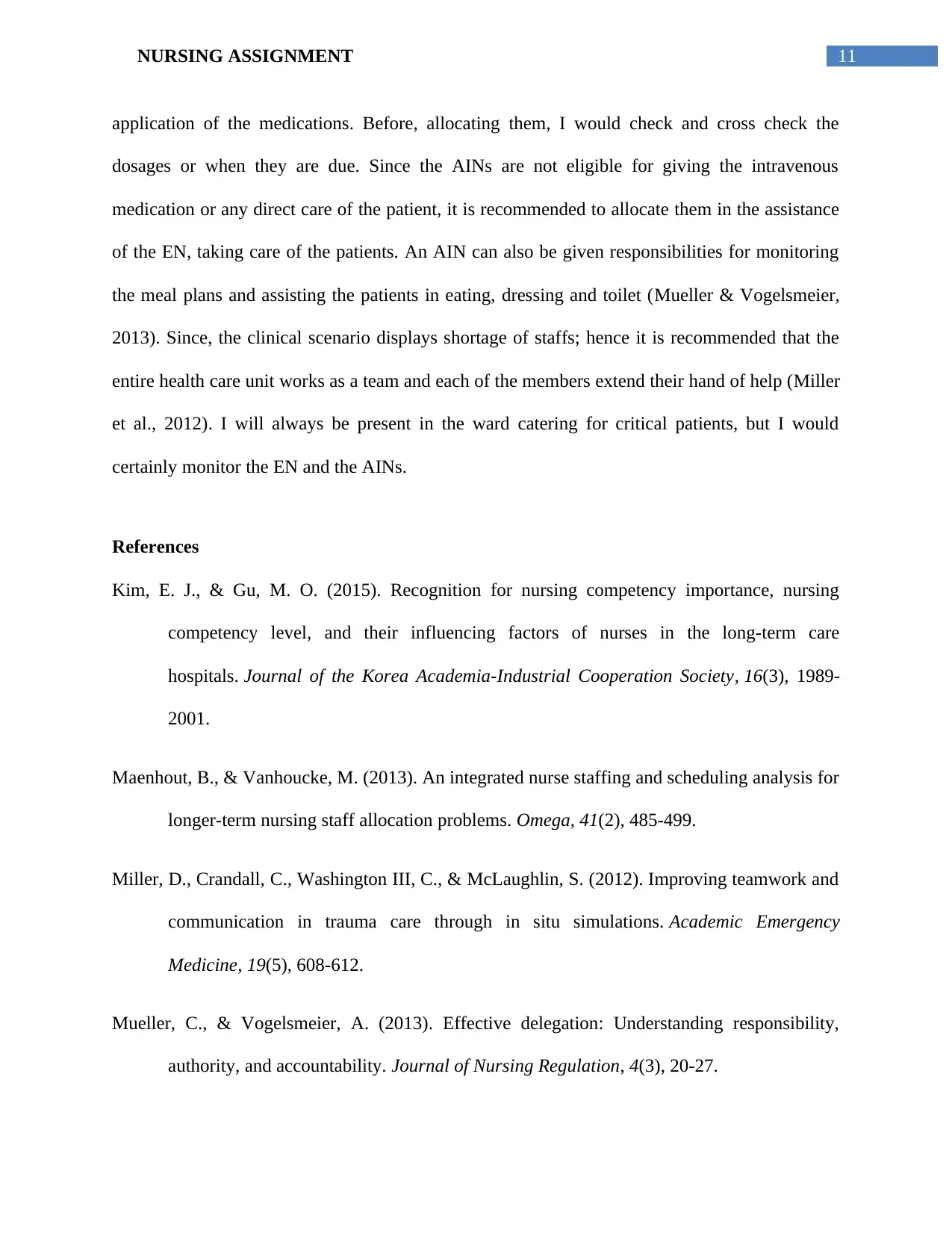
11NURSING ASSIGNMENT
application of the medications. Before, allocating them, I would check and cross check the
dosages or when they are due. Since the AINs are not eligible for giving the intravenous
medication or any direct care of the patient, it is recommended to allocate them in the assistance
of the EN, taking care of the patients. An AIN can also be given responsibilities for monitoring
the meal plans and assisting the patients in eating, dressing and toilet (Mueller & Vogelsmeier,
2013). Since, the clinical scenario displays shortage of staffs; hence it is recommended that the
entire health care unit works as a team and each of the members extend their hand of help (Miller
et al., 2012). I will always be present in the ward catering for critical patients, but I would
certainly monitor the EN and the AINs.
References
Kim, E. J., & Gu, M. O. (2015). Recognition for nursing competency importance, nursing
competency level, and their influencing factors of nurses in the long-term care
hospitals. Journal of the Korea Academia-Industrial Cooperation Society, 16(3), 1989-
2001.
Maenhout, B., & Vanhoucke, M. (2013). An integrated nurse staffing and scheduling analysis for
longer-term nursing staff allocation problems. Omega, 41(2), 485-499.
Miller, D., Crandall, C., Washington III, C., & McLaughlin, S. (2012). Improving teamwork and
communication in trauma care through in situ simulations. Academic Emergency
Medicine, 19(5), 608-612.
Mueller, C., & Vogelsmeier, A. (2013). Effective delegation: Understanding responsibility,
authority, and accountability. Journal of Nursing Regulation, 4(3), 20-27.
application of the medications. Before, allocating them, I would check and cross check the
dosages or when they are due. Since the AINs are not eligible for giving the intravenous
medication or any direct care of the patient, it is recommended to allocate them in the assistance
of the EN, taking care of the patients. An AIN can also be given responsibilities for monitoring
the meal plans and assisting the patients in eating, dressing and toilet (Mueller & Vogelsmeier,
2013). Since, the clinical scenario displays shortage of staffs; hence it is recommended that the
entire health care unit works as a team and each of the members extend their hand of help (Miller
et al., 2012). I will always be present in the ward catering for critical patients, but I would
certainly monitor the EN and the AINs.
References
Kim, E. J., & Gu, M. O. (2015). Recognition for nursing competency importance, nursing
competency level, and their influencing factors of nurses in the long-term care
hospitals. Journal of the Korea Academia-Industrial Cooperation Society, 16(3), 1989-
2001.
Maenhout, B., & Vanhoucke, M. (2013). An integrated nurse staffing and scheduling analysis for
longer-term nursing staff allocation problems. Omega, 41(2), 485-499.
Miller, D., Crandall, C., Washington III, C., & McLaughlin, S. (2012). Improving teamwork and
communication in trauma care through in situ simulations. Academic Emergency
Medicine, 19(5), 608-612.
Mueller, C., & Vogelsmeier, A. (2013). Effective delegation: Understanding responsibility,
authority, and accountability. Journal of Nursing Regulation, 4(3), 20-27.

12NURSING ASSIGNMENT
1 out of 13
Related Documents
Your All-in-One AI-Powered Toolkit for Academic Success.
+13062052269
info@desklib.com
Available 24*7 on WhatsApp / Email
![[object Object]](/_next/static/media/star-bottom.7253800d.svg)
Unlock your academic potential
© 2024 | Zucol Services PVT LTD | All rights reserved.





